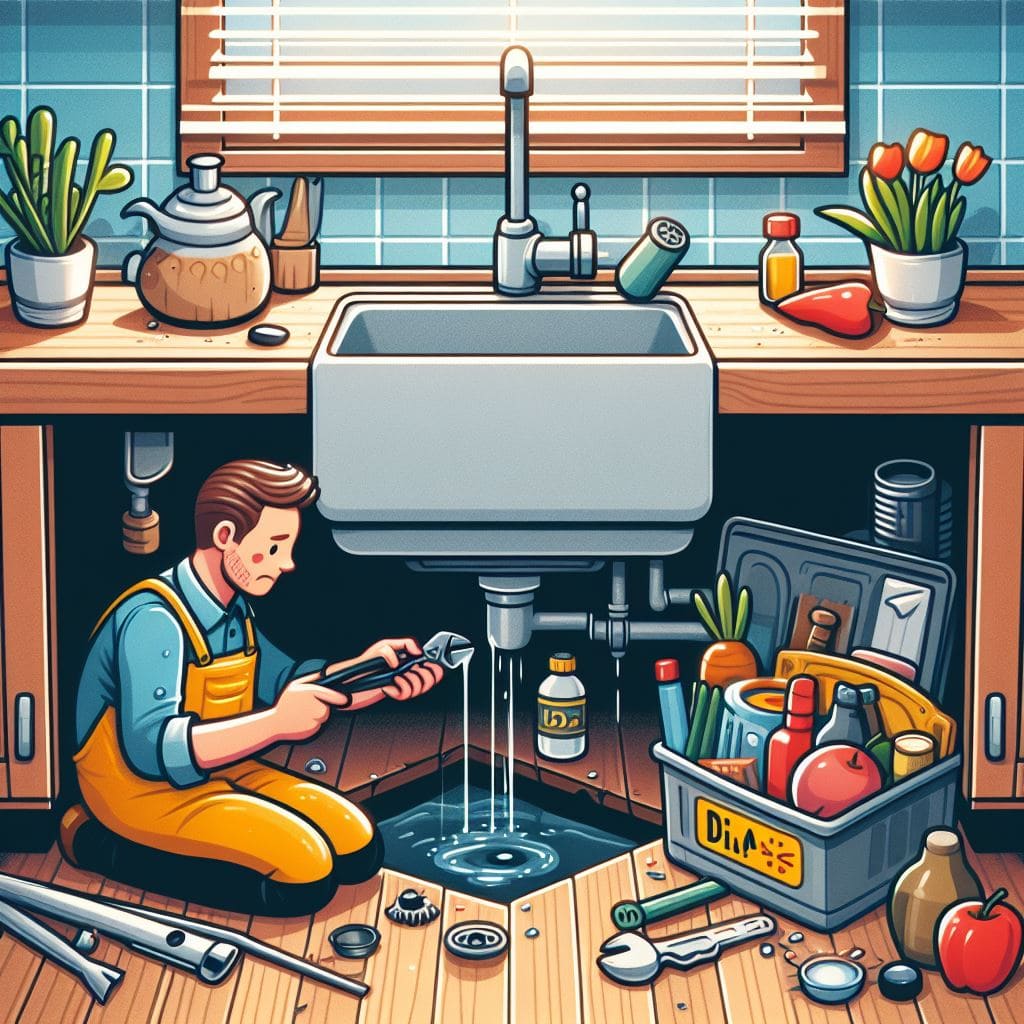To fix a leak under your kitchen sink, first identify the source of the leak and shut off the water supply. Then, either tighten the connections or replace the damaged component.
Fixing a leak under your kitchen sink can be a straightforward task that homeowners can often handle without professional help. Leaks typically occur at the sink’s drain, at the connection point between the sink and the P-trap, or where the pipes join. In this article, we provide valuable tips on how to fix leak under kitchen sink.
Being a common issue, it’s essential to address it promptly to prevent water damage and mold growth. Having the right tools and replacement parts at hand, such as wrenches, plumbers’ tape, and gaskets, can expedite the repair process. Follow the initial steps of diagnosis and quick action to ensure a dry and functional kitchen sink.

Common Causes Of Leaks Under The Kitchen Sink
-
Loose Connections: Daily use can loosen the pipes under your sink.
-
Worn Out Seals: Over time, seals can deteriorate and create gaps.
-
Corroded Pipes: Pipes may rust and weaken, causing leaks.
-
Blocked Drains: Clogs can build pressure and lead to leaks.
Signs That Indicate A Leak Under Your Sink
-
Water Puddle: The most visible sign is water under the cabinet.
-
Mold Growth: A musty smell or mold indicates lingering moisture.
-
Water Stains: Discoloration inside the cabinet suggests a drip.
-
Damaged Items: Warped cabinet bases or peeling surfaces can be clues.
Preparation Steps Before Addressing The Leak
-
Clear the Area: Remove items to access the leak site easily.
-
Turn Off Water: Always shut off the sink’s water valve first.
-
Check for Dampness: Use a towel to dry the area and spot the leak.
-
Gather Tools: Have wrenches, Teflon tape, and buckets on hand.
How to Fix Leak Under Kitchen Sink
Discover simple solutions to a leaky kitchen sink with these quick fixes. Minor leaks demand prompt attention to prevent damage and wastage. Even beginners can tackle these issues with ease. Follow these straightforward steps to seal the dripping nuisance efficiently.
Tightening Connections And Fixtures
Sometimes, a simple twist is all that’s needed. Loose pipes and fittings are common culprits behind sink leaks.
- Inspect: Check under the sink for loose connections.
- Adjust: Use a wrench to gently tighten each joint.
- Test: Run water to ensure the leak stops.
Replacing Worn-out Washers And Gaskets
Washers and gaskets seal the deal but wear out over time. A simple swap can plug that leak.
- Turn off water: Stop the supply before you start.
- Disassemble: Remove the fixture carefully.
- Replace: Fit in new washers or gaskets where needed.
- Reassemble: Put everything back and check for drips.
Applying Plumbing Tape To Small Leaks
A little tape can go a long way for minor leaks. Plumbing tape creates a watertight seal with minimal effort.
| Step | Action | Tips |
|---|---|---|
| 1. | Clean the area around the leak. | Ensure it’s dry and free of debris. |
| 2. | Wrap plumbing tape around the thread. | Keep it tight and even. |
| 3. | Reconnect and tighten the fitting. | Don’t over-tighten to avoid damage. |
Addressing Major Leak Issues
Dealing with major leaks under your kitchen sink can be daunting. Your kitchen is vital, a place where you prepare meals and gather with family. A leak not only disrupts these moments but can also cause serious water damage. Fear not, as tackling these leaks is manageable with the right approach. Understanding how to fix common issues like a damaged P-trap, leaky sink strainer, or pesky garbage disposal leaks is crucial for any homeowner.

Replacing A Damaged P-trap
A P-trap is the U-shaped pipe that keeps odors from coming up through the sink. Leaks here often mean the P-trap is damaged.
- Start by clearing out the cabinet under the sink.
- Place a bucket directly below the P-trap to catch water.
- Unscrew the connectors using pliers or a wrench.
- Remove the P-trap and check for cracks or damage.
- If damaged, take it to a hardware store to find a match.
- Replace with a new P-trap and tighten the connectors firmly.
- Run water to test for any leaks.
Fixing Leaky Sink Strainer
The sink strainer might be the culprit if water pools directly under the sink basin.
- Loosen the locknut that holds the strainer in place.
- Remove the strainer and scrape off old putty.
- Apply a generous bead of plumber’s putty around the drain opening.
- Reinstall the strainer, press firmly, and replace the locknut.
- Wipe away excess putty and check for leaks.
Dealing With Garbage Disposal Leaks
Leaks from the garbage disposal typically occur at the sink flange or drain lines.
For sink flange leaks:
- Disconnect and remove the garbage disposal unit.
- Reapply plumber’s putty around the flange and reinstall the unit.
- Securely tighten the mounting bolts.
For drain line leaks:
- Locate the leaking spot on the drain line and tighten the connections.
- If the leak continues, replace the gasket or the drain line.
- Ensure everything is securely fastened and leak-free.
Preventive Measures And Maintenance Tips
Dealing with a kitchen sink leak can be frustrating but taking the right steps can prevent this issue. Regular maintenance and proactive measures keep your plumbing in top shape, dodging costly repairs. Dive into useful tips that safeguard your kitchen from unwanted leaks.
Routine Maintenance To Prevent Future Leaks
Keeping your kitchen leak-free starts with regular check-ups.
- Inspect sink pipes every month for signs of moisture or corrosion.
- Check under the sink for damp spots or mold growth.
- Clean the P-trap, removing debris that could cause clogs and leaks.
- Ensure drain seals and gaskets are intact; replace if they show wear.
Upgrading Sink Components For Longevity
Upgrade sink parts for improved durability.
- Invest in high-quality faucets and valves with robust warranties.
- Switch to stainless steel or PVC pipes for a trouble-free service life.
- Choose silicone-based sealants for a stronger, longer-lasting seal.
- Opt for a water filter system to reduce pipe-damaging minerals.
When To Call A Professional Plumber
Some issues need expert attention.
- Large leaks that persist after DIY repairs
- Low water pressure combined with leaks
- Water damage signs like warping or staining
- Persistent odors that could point to a hidden leak
When facing such signs, reach out to a licensed plumber for a thorough investigation and repair.

Ending Words
Tackling a leak under your kitchen sink doesn’t have to be daunting. With the steps outlined, you can address the issue confidently. Remember, regular maintenance keeps bigger problems at bay. Still, if the task seems overwhelming, don’t hesitate to call a professional.
Frequently Asked Questions On How To Fix Leak Under Kitchen Sink
What To Do If Sink Is Leaking Underneath?
Turn off the water supply to stop the leak immediately. Check the sink’s P-trap and tighten any loose connections. Replace worn washers or gaskets. If unsure or unresolved, consult a professional plumber. Regular maintenance helps prevent future leaks.
How Much Does It Cost To Fix A Leak Under A Kitchen Sink?
The cost to fix a leak under a kitchen sink typically ranges from $150 to $350, depending on the complexity of the repair.
How Do You Fix A Leaky Hose Under A Kitchen Sink?
Turn off the water supply. Inspect the hose to locate the leak. Tighten any loose connections with a wrench. Replace worn-out washers or gaskets. If the hose is damaged, consider replacing it entirely. Recheck for leaks after turning the water back on.
How Do I Seal The Pipe Under My Kitchen Sink?
First, clear the area under your sink. Shut off water and remove any debris. Apply plumber’s putty or silicone sealant around the pipe’s base. Press it firmly against the sink bottom. Let it dry as per product instructions, ensuring a watertight seal.







